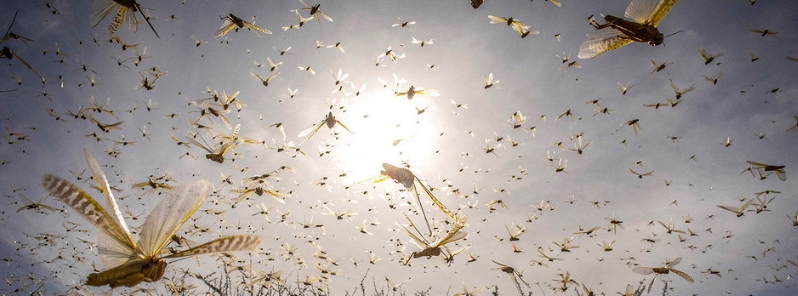Second and unprecedented wave of locust invasion expected to hit Pakistan

Another unprecedented wave of locust plague is expected to hit Pakistan by the end of May 2020, posing threats of food security crisis and livelihood losses. The invasion will start from the southwestern province of Balochistan, passing through the cropping area of southern Sindh province during the migration, according to the Ministry of National Food Security and research.
Desert locusts are expected to migrate from Iran and other areas to the summer breeding regions in Sindh, as well as eastern Punjab provinces, the ministry added, noting that it will be difficult to contain the movement of the insects but measures will be taken.
"Slowly and gradually, these locusts are eating away at everything in cultivated lands. Now, they are moving towards other fields in nearby villages," said a farmer named Maulvi Satar Baloch. Other residents of Garang in Washuk district, said desert locusts are growing day by day in the area.
The UN's Food and Agriculture Organization (FAO) warned of a potentially serious food security crisis and major livelihood losses unless prompt action is taken to contain the insects breeding in parts of Balochistan, Sindh, and Punjab.
@jam_kamal @Senator_Baloch @Xadeejournalist @ZarrarKhuhro @WusatUllahKhan @shazbkhanzdaGEO attack of Locust in Balochistan pic.twitter.com/O6cNnG69tS
— Eijaz Ali (@EijazAli10) May 5, 2020
Locust attack in Balochistan Lohi Union council taluka Dhureji district Lasbela , same danger as corona in human and locust is similiar Corona virus in agriculture sector @jam_kamal @zobaida_jalal @WusatUllahKhan @Xadeejournalist @ZarrarKhuhro pic.twitter.com/kdav70wOUh
— Eijaz Ali (@EijazAli10) May 5, 2020
impact LOCUST attack in Balochistan &Sindh @jam_kamal @zobaida_jalal @MuradAliShahPPP pic.twitter.com/gjjiwcxIqe
— Eijaz Ali (@EijazAli10) May 6, 2020
In response to the threat, the Pakistani government announced a national emergency in February and a national action plan, in collaboration with the affected provinces.
The ministry said in a statement that agencies like the National Disaster Management Authority (NDMA) and provincial agricultural departments are working together for the purpose of survey and control. Military units are also sent for support.
Survey reports are done regularly with FAO for acquiring technical support. "In southwest Asia, hopper groups and bands are present in southern Iran and in Pakistan where substantive control operations continue," FAO stated.
"Adult groups and small swarms from breeding in Balochistan, the Indus Valley, and Punjab in Pakistan will move to desert areas along both sides of the Indo-Pakistan border from now onwards."
"This is expected to be supplemented by several waves of swarms coming from the spring breeding areas during June."
Strong measures have been taken to assess the land areas in all the provinces, with a total of 153 665 square km (59 553 square miles) surveyed so far.
Spray on locust nymphs has been done at Marap Dhor, Khaliq Abad, Alizai and Chilbaghoo Dam areas of District Surab.@jam_kamal pic.twitter.com/Lt66panp8V
— PDMA Balochistan (@PDMABalochistan) May 6, 2020
#Washuk Balochistan # Locust More Dangerous then Covid-19. Pictures show the #Locust # eating Leaves of Dates Palms. Same for other crops too. e.g (Onion , cotton , Water and Sweet melons. Need quick action to Control.@ImranKhanPTI @jam_kamal @Senator_Baloch @mmatalpur pic.twitter.com/aRf1jWswP0
— Naik Muhammad (@Baloch123Naik) May 7, 2020
Featured image credit: FAO emergencies

Commenting rules and guidelines
We value the thoughts and opinions of our readers and welcome healthy discussions on our website. In order to maintain a respectful and positive community, we ask that all commenters follow these rules.